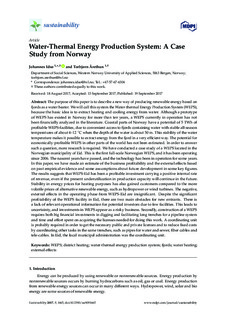| dc.description.abstract | The purpose of this paper is to describe a new way of producing renewable energy based on fjords as a water heater. We will call this system the Water-thermal Energy Production System (WEPS), because the basic idea is to extract heating and cooling energy from water. Although a prototype of WEPS has existed in Norway for more than ten years, a WEPS currently in operation has not been financially analyzed in the literature. Coastal parts of Norway have a potential of 5 TWh of profitable WEPS-facilities, due to convenient access to fjords containing water with stable all-season temperatures of about 4–12 °C when the depth of the water is about 50 m. This stability of the water temperature makes it possible to extract energy from the fjord in a very efficient way. The potential for economically-profitable WEPS in other parts of the world has not been estimated. In order to answer such a question, more research is required. We have conducted a case study of a WEPS located in the Norwegian municipality of Eid. This is the first full-scale Norwegian WEPS, and it has been operating since 2006. The nascent years have passed, and the technology has been in operation for some years. In this paper, we have made an estimate of the business profitability and the external effects based on past empirical evidence and some assumptions about future development in some key figures. The results suggests that WEPS-Eid has been a profitable investment carrying a positive internal rate of revenue, even if the present underutilization in production capacity will continue in the future. Stability in energy prices for heating purposes has also gained customers compared to the more volatile prices of alternative renewable energy, such as hydropower or wind turbines. The negative, external effects in the operating phase from WEPS-Eid are insignificant. Despite the significant profitability of the WEPS facility in Eid, there are two main obstacles for new entrants. There is a lack of relevant operational information for potential investors due to few facilities. This leads to uncertainty, and investments in WEPS appear as a risky business. Secondly, construction of a WEPS requires both big financial investments in digging and facilitating long trenches for a pipeline system and time and effort spent on acquiring the licenses needed for doing this work. A coordinating unit is probably required in order to get the necessary public and private licenses and to reduce fixed costs by coordinating other tasks in the same trenches, such as pipes for water and sewer, fiber cables and tele-cables. In Eid, the local municipal administration was the coordinating unit | nb_NO |

